Top News
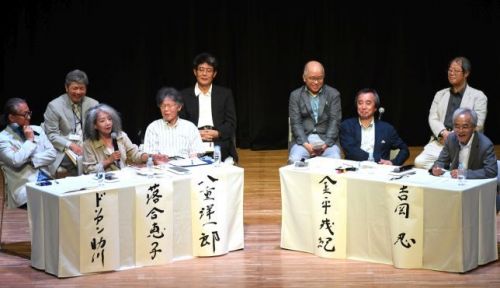
May 20, 2018 Ryukyu Shimpo
On May 20 the Japan P.E.N. Club held its 34th Day of Peace Symposium at the Okinawa Convention Center, which was themed “People, Island Life, Okinawa and Literature.”
Nine authors, poets, and journalists attended from outside of Okinawa, giving keynote speeches and holding a panel discussion.
Expressive persons in the realm of Okinawan literature that depicts military base issues and the Battle of Okinawa spoke together with the goals of conveying Okinawa’s suffering nationwide and brainstorming what literature can do for peace.
This is the first time this event was held in Okinawa. Eight hundred people attended and listened eagerly to the writers’ arguments.
Former president of the Japan P.E.N. Club and novelist Jiro Asada gave a keynote speech titled “How War and Literature are Considered in Okinawa.” Asada said, “Literature depicts the truths of human suffering.
Without suffering, literature cannot be born.
” He touched on Okinawa being at the mercy of military base issues with the words, ”
Even now, Okinawa is experiencing the prolonged anguish of war. Ironically, Okinawan literature emits radiant brilliance.”
Participating in the subsequent panel discussion were Asada; writers Shinobu Yoshioka, Keiko Ochiai and Dorian Sukegawa; literary critic Minato Kawamura; journalist Shigenori Kanehira; Okinawan writers Sadatoshi Oshiro and Eiki Matayoshi; and poet Yoichiro Yae.
Oshiro spoke about Okinawan literature that paints images of Okinawa, military base issues, and the like. He said, “[Okinawa] suffers damages from the bases, injury from the power of the state, and even when we [Okinawans] raise our voices we are depicted as weaklings.
This is why such literature is born in Okinawa.
I hope we pursue literature’s potential to ethically fight against authority, in correspondence with the times and circumstances.”
Matayoshi said, “U.S. military bases are causing various problems throughout the world.
Okinawan literature is universally relevant in that it depicts Okinawan people’s tyrannization by the bases.”
Kawamura said, “In the several decades of the postwar period, Okinawa has continued to be controlled by the U.S. military, and is still tormented by bases that have not been even slightly diminished since Okinawa’s return [to Japan]. As such, Okinawan literature has the power to change Japanese literature, and I especially want mainland people to read it.
(English translation by T&CT and Erin Jones)
Go to Japanese
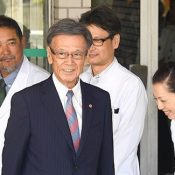
May 15, 2018 Ryukyu Shimpo online edition
On May 15 at 1:30 p.m., Governor Takeshi Onaga held a press conference at the Prefectural Office, where he released information about his surgery and physical health.
That morning he was discharged from a hospital in Urasoe City.
Onaga announced that his pathological examination showed that the tumor in his pancreas was malignant, and was found to be stage II pancreatic cancer.
Furthermore, he explained that there were no tumors found elsewhere in his organs, and that the cancerous tumor was removed.
He expressed his intention to pursue medical treatments to monitor for relapse or metastasis.
In addition, he mentioned his desire to return to work while recovering his physical health with the words, “I want to come back to work even one day sooner, so that I can carry out the role of governor which was conferred upon me.”
In regard to the spread of the cancer, Onaga said, “[Cancer] was confirmed in one lymph node in the vicinity of my pancreas, and it was removed.”
He is aiming to put all his energy into being cured so he can return to work and fulfill his duties until his term of office ends in December.
In regard to the gubernatorial election in autumn and his intention to run for a second term, Onaga said, “By reliably fulfilling my duties day after day I wish to put my trust in Okinawans’ judgement.
Since I have become healthier in the joyful few days since my discharge from the hospital, I wish to meet my responsibilities by readily performing official business.” He did not give specifics.
(English translation by T&CT and Erin Jones)
Go to Japanese
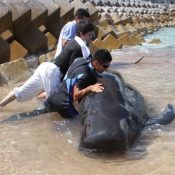
May 20, 2018 Ryukyu Shimpo
Nago – A rescue party was spontaneously formed on May 19 after a 4.85 meter-long short-finned pilot whale was found washed ashore at Nago Bay.
The rescue party included the person who initially discovered the whale and some employees from the Okinawa Churashima Foundation, and after a six hour effort, the whale was safely returned to the sea, swimming off in good condition.
Around 8:30 a.m. on May 19, Toru Oshiro, 44, from Nago City was headed north on Route 58 when he noticed a black shape moving in the water.
“I thought it might be a person drowning and I went closer, and that was when I saw the fin,” he said.
The whale closed its eyes in pain and moved its tail and dorsal fins and blowing out water.
The animal was injured, and blood was flowing out into the ocean.
At about 9:45, Osamu Higa from the Churashima Foundation animal control team arrived, and he and Oshiro combined their strength to right the whale’s body. Saying things like, “Don’t give up” and “Put your strength into it,” to the whale, they were able to move the whale’s body with some help from the waves and secure an open airway for the large ocean mammal.
After that, Higa spent a number of hours in the water, supporting the whale’s body.
The whale’s breathing, which was rapid when it was first found, gradually returned to normal. Nozomi Kobayashi from the Churahsima Foundation Research Center said, “A whale’s body is heavy, and when it dries out it puts extra strain on the organs, making it unable to get back into the water under its own power.
By getting it back into the water, its breathing was able to return to normal.”
Just after 2:00 p.m., some local fishermen arrived with a boat and helped get the whale back into the deeper waters of Nago Bay.
Oshiro, who first discovered the whale, said, “I am happy that we were able to get it back into the ocean healthy.”
(English translation by T&CT and Sam Grieb)
Go to Japanese
May 15, 2018 Ryukyu Shimpo
On May 15, 1972, Okinawa was returned to Japanese control. In November of 1971, at the 67th extraordinary Diet, also known as the Okinawan Diet, Chief Executive of the Government of the Ryukyus Chobyo Yara submitted a proposal outlining steps to return Okinawa to Japan. In the introduction section of the proposal, it wished for, “A return as an island of peace, free of military bases.”
Even after the return to Japan, the most significant burden was, and continues to be without any signs of improvement, the existence of U.S. military bases. At the time of the reversion, 75% of all U.S. military facilities in Japan were located in Okinawa.
This has only been reduced to 70%, and there are no signs of any future reductions.
From incidents such as the rape and murder of a woman by a base worker in 2016, the crash landing of an MV-22 Osprey in Abu, Nago City the same year, or the window that fell from a U.S. military helicopter onto the grounds of Futenma Dai-ni Elementary School in 2017, accidents and incidents occur frequently and threaten the lives of Okinawan residents.
While the government has promised to reduce the burden of U.S. bases on Okinawa, the Abe administration is continuing to force through the relocation of MCAS Futenma to newly constructed facilities in Henoko, Nago City. The governor of Okinawa strongly opposes this, and in the Okinawan general election, where the new base construction became a major point of contention, candidates who opposed the construction were by-and-large elected.
The “establishment of self-governance,” championed by Yara’s proposal is being impeded by the central Japanese government forcing this construction on Okinawa.
The proposal also spoke of, “organic Okinawan economic development.
” While well behind stimulus packages for mainland Japan, about 10 trillion yen has been invested in “stimulus and development costs,” as part of Okinawan stimulus policy.
This has certainly progressed infrastructure such as roads and ports.
However, income in Okinawa is only about 70% of the national average, and the poverty stemming from the nation’s worst unemployment rate has yet to be addressed.
The child poverty rate is over two times the national average.
Childcare services are meager, waiting lists are long, and childcare expenses are high.
The declining birthrate on an island so distant from the rest of Japan has also become dire.
Previous Okinawa Promotion Plans leaned heavily towards infrastructure, and efforts to enact education and welfare policies have been neglected.
There needs to be a fundamental change to the Okinawan Promotion Plan.
The Okinawan economic stimulus payment, which began in 2012, has lost its original intention wherein Okinawa could use the money for the budget at their own discretion, and is now being decided by the Japanese government in return for agreement on the base policy, turning it into something that suits the needs of the central government, not Okinawa.
This only further serves to amplify the distorted nature of Okinawan economic promotion.
The Okinawan Promotion Plan based on the Act on Special Measures for the Promotion and Development of Okinawa passed at the same time as the reversion, is already halfway through its fifth iteration.
With the end of the fifth iteration approaching, the time has come where we must discuss the next Okinawan Promotion Plan, and seriously consider how we can achieve, “organic Okinawan economic development.”
The new image for Okinawa envisioned in the reversion proposal depicted Okinawan’s deciding their future for themselves, and not having it decided for them by Japan.
Let us state the hope of the people of Okinawa, born of their experience languishing in oppression, both from the brutal Battle of Okinawa as well as the following American occupation.
Independence and autonomy.
Accomplishing this is the responsibility of our generation for the generation that follows.
The conference on Okinawan autonomy announced their framework of “Okinawan Empowerment,” and is advocating for a fundamental change centered on Okinawan promotion and autonomy.
We should make it a day to think about the future of Okinawa.
(English translation by T&CT and Sam Grieb)
Go to Japanese

May 18, 2018 Ryukyu Shimpo
By Chie Tome
“Dear Okinawan mom in heaven, thank you for making me your daughter.
” Crystal Joy Kinjyo (English name Teesa Houston), age 30, is a vocalist, singer, and songwriter of KOLAJ, a band that is based in Los Angeles.
She had grown up in the United States not knowing that she had been adopted twice in Okinawa.
Now that she has a career as a professional musician, Crystal decided to spend time looking into her roots, which she had been ignoring up until recently. For the first time in 27 years, she returned to Okinawa.
Crystal was originally born in Nagoya City to Filipino parents.
But due to overlapping complications, such as both of her parents working illegally and for being illegal immigrants, she was taken in by Gloria Kinjyo, who was half Okinawan and half Filipino, shortly after she was born.
Up until she was five-months-old, Crystal had lived with Gloria in Naha City.
But due to threats and persistent harassing by Crystal’s biological mother and others, Gloria put her daughter’s safety first and decided to let an American couple living in Okinawa adopt Crystal instead.
Crystal became an American and traveled to the continental U.S. when she was two-years-old.
Crystal looked back on her adolescence and said, “My U.S. parents who raised me had told me that my biological mother was an Okinawan woman who had been raped by a U.S. soldier.
I didn’t want to know that kind of background and I never thought of seeking the truth.”
Things changed in 2015, when Crystal started her career as a professional musician.
This is when she decided it was necessary for her to re-evaluate her own identity.
All she had was her Okinawan mother’s name, Gloria Kinjyo.
She collected information using her mother’s name at the Filipino Embassy.
She was able to obtain Gloria’s address and contact information in Okinawa.
For the first time in 25 years, Crystal made contact with Gloria via a social networking site (SNS) and discovered the true story.
They had promised to meet one another, however Gloria passed away at age 57 due to an illness last July, so they were unable to see each other again.
But Crystal at least wanted to hug Gloria’s grave, so she still decided to travel to Okinawa.
She was able to meet Gloria’s older brother and nieces, along with visiting places connected to Gloria.
She was also able to talk with people who knew Gloria.
The more she got to know Gloria through stories, the more similarities she found, such as being good at song and dance, along with having a strong sense of justice.
Having similar characteristics to Gloria despite not being related by blood, Crystal felt a “mother-daughter bond.”
She said, “If back then, my Okinawan mother had not taken me from my biological mother, then I may have gotten involved in drugs and prostitution.” She was touched by the bravery and deep love of an Uchinanchu woman, who took in another person’s child regardless of her own safety.
“My Okinawa mother is my angel.
I would like to cherish this island that my mother lived on as a second home.
” Crystal, facing her past for the first time, renewed her enthusiasm toward her career and said, “I would like to express an even more true-to-life version of myself in my songs.”
(English translation by T&CT and Chelsea Ashimine)
Go to Japanese

May 5, 2018 Ryukyu Shimpo
An Iriomote cat, one of Japan’s protected species, was found dead on prefectural route 215 in Taketomi town on Iriomote Island around 6:00 AM on May 4. The cause of death is thought to be by traffic accident, and it is the third case its kind reported this since April 26 this year.
According to the Ministry of the Environment’s Iriomote Wildlife Conservation Center, the Iriomote cat was female. The body was 77 centimeters long and weighed 3.2 kilograms. The cat was found on a road with multiple wounds and broken bones. The ranger at the center, Shota Sugimoto, commented, “The damage could have only been some injuries if the vehicle had driven slowly. We hope drivers will drive with caution.”
(English translation by T&CT and Sayaka Sakuma)
Go to Japanese
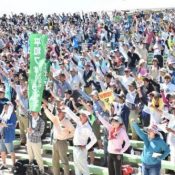
May 14, 2018 Ryukyu Shimpo
In the afternoon on May 13 at Ginowan Seaside Park’s Outdoor Theater, the 5/15 Peace March Action Committee and the Okinawa Peace Movement Center held a prefectural citizens’ rally to protect peace and life.
In commemoration of 46 years since Okinawa’s return to Japan following its postwar occupation by the U.S. military, those gathered called for a peaceful Okinawa devoid of U.S. bases to be made a reality.
The organizers estimated that from May 11 through 13, 3500 people attended the prefectural rally following their participation in the Peace March.
Those gathered fervently called for alleviation of Okinawa’s overlarge share of the base burden.
Chairman of the 5/15 Peace March Action Committee and the Okinawa Peace Movement Center Hiroji Yamashiro spoke at a greeting from the organizers.
He said, “Matters like land reclamation in Henoko and reinforcement of bases in the Sakishima Islands are teeming with many problems.
We have clasped hands with our colleagues nationwide and throughout Okinawa, and renewed our determination to proceed with vigor.”
House of Representatives member Kantoku Teruya called for solidarity and participation from outside Okinawa.
He said, “I hope that over these three days of the march that our true sentiments cross prefectural boundaries and are felt throughout Japan, and cross national boundaries to produce a huge movement of solidarity throughout the world.” Teruya went on to express that Okinawans are not seeking pity or charity, rather, they want to be earnestly supported as equals.
An announcement at the rally touched on the denuclearization agreement made at the inter-Korea summit, stating, “As East Asia speeds toward peace and security, the time is coming to make drastic revisions to the U.S.-Japan Security Treaty and the Status of Forces Agreement.”
In addition it was declared that, “We must stand firm against the reckless charge of our self-righteous government, which would renounce war and specify a self-defense force in Article 9, then in a return to the pre-war period would push toward war. We oppose the reinforcement and expansion of U.S. military bases that the U.S. and Japanese governments are forcing through.”
On the morning of May 13, the final day of the 5/15 Peace March, participants separated into two groups and walked around Futenma Air Station along a central north region “base” course and a southern “old battlefield” course, converging at the meeting place of the prefectual rally.
According to organizers, about 5400 people in total participated in the Peace March along the “base” and “old battlefield” courses over the three days from May 11 through 13.
(English translation by T&CT and Erin Jones)
Go to Japanese
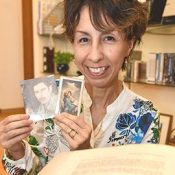
May 15, 2018 Ryukyu Shimpo
By Hiroshi Massaki
A woman began searching for her estranged father, an ex-U.S. Marine, 30 years after she was separated from him shortly after birth in 1969, just before the reversion of Okinawa to Japan.
Her name is Michiko Oshiro, 48, from Haebaru. Her father had already passed away in the U.S., however Oshiro got in touch with her American grandmother and aunt, and at the end of next month will get to visit his hometown for the first time.
Oshiro, who has kept pictures of her father close, said, “In trying times, and when I was sad, I would always lean on the existence of my father.
I thought ‘I finally get to meet him,’ and I want to embrace his gravestone.”
Oshiro’s mother, Keiko, met Jimmy Morales when he was stationed in Okinawa, and later gave birth to Michiko.
They gave up on getting married due to opposition from Morales’ mother, so Jimmy returned to the U.S. Also, the military would send him here and there as they pleased.
Oshiro does not remember ever seeing her father’s face.
Since her mother rarely spoke of him, to this day she still does not know many details about him.
Starting in 1996, Oshiro began searching for news of her father, inquiring at places like the U.S. consulate in Okinawa. Three years later, she found an envelope with her father’s home address written on it.
She wrote a letter to the address, and one month later, received a reply from America.
The sender was her father’s parents.
“This is the first I’ve heard of your existence, for which I am surprised and moved.
However, I have some awful news I must share with you,” was written, after which Oshiro learned that Jimmy had been killed nine years before.
Oshiro’s mother, who usually does not cry, sobbed loudly. Oshiro cried as well. “Of course, I wanted to meet him at least once. I just wanted him to embrace me.”
Meanwhile, Oshiro continued to exchange letters with her American grandmother and aunt.
Letters came about once or twice a year, and Oshiro saved them all in a folder.
Now, she uses an app on her smartphone to exchange pictures and messages with her aunt.
On her birthday she received flowers and a message that said, “Even though it has been lonely up until now, you are not alone.” Oshiro was brought to tears again.
When she was a child she was called “gaijin,” and lived a hard life being raised by a single mother.
She also battled illness.
When times were tough, she would take out the pictures of her father and say out loud, “Papa, watch over me.”
From June 20, Oshiro will visit her father’s tombstone in his Texas hometown.
Since her mother died 10 years ago, she will be accompanied by her husband Masanobu, 52.
It has been 19 years since she got in contact with her American grandmother, and 48 years since she was separated from her father.
She learned that she has nine half-siblings.
According to Oshiro, “It’s truly like a dream.
From my mother who gave birth to me and raised me, and the father who supported me, I am thankful for my family.
I am glad I did not give up.”
(English translation by T&CT and Sam Grieb)
Go to Japanese
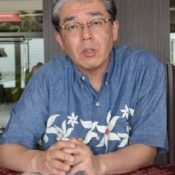
May 8, 2018 Ryukyu Shimpo
For fiscal year 2018, JTB, the largest domestic travel agency in Japan, is training 300 of their salespersons from all over the country in Okinawa.
These salespersons sell tours at the front line.
The purpose of this training is to increase JTB’s selling power for Okinawa’s tourism by learning about Okinawa.
In April of this year, JTB integrated 15 of its branches across Japan, making this the first training to take place on a national level.
In April, the first group of salespersons, comprised of about 60 people, took part in a training vacation in Okinawa for two-nights and three-days.
They experienced checking in to rent a car and visited tourist attractions such as the Ryukyu Village.
The participants voiced their enthusiasm saying they would like to utilize the information that they gained toward their sales.
Sometime between October of 2019 and March of 2020, the second runaway of Naha Airport is expected to be completed.
JTB plans to roll out their travel campaign, “Seasons of Japan” in Okinawa around that time to continuously strengthen the operations of Okinawa’s tourism.
To stimulate the expansion of incoming tourists, they plan to roll out their travel campaign prior to the second runway being completed.
Managing Executive Officer and General Manager of Domestic Stock Goods Shinichiro Moriguchi recently responded to an interview with Ryukyu Shimpo. Moriguchi was enthusiastic.
He said, “Okinawa is a locale where sales increase the more you describe the product to the customers.
By having all of our employees focusing on Okinawa, I feel that we will be able to sell with confidence.
The entire company will be involved in this.”
(English translation by T&CT and Chelsea Ashimine)
Go to Japanese
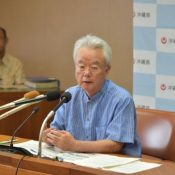
May 10, 2018 Ryukyu Shimpo
Looking to solidify the plan to stimulate the Okinawa economy starting 2022 onwards, Okinawa vice governor Moritake Tomikawa delivered a progress report on the new Okinawa development strategy May 9 at the Prefectural Office.
Vice-governor Tomikawa said that the goal of the strategy was, “To utilize Okinawa’s role as the bridgehead to Asia, further contributing to Japan’s economy,” highlighting nine areas to explore including a turning the airport into a world-class international hub, forming an international cruise hub, and introducing a rail system among others.
Additionally, he explained that, “One of the large hurdles to get over is the argument, ‘Why do we need another 10 years for an Okinawan stimulus plan that has already been going on for the past 50?’
If we do not proceed with a scenario that leads to the revitalization of Japan’s economy, the next steps become difficult.” He stressed that utilizing Okinawa as a “launch pad” to Asia plays a significant role in the strength of Japan’s economy.
The current Okinawa stimulus plan (Okinawa 21st Century Vision) will finish at the end of 2021, so this year with their focus on the post-plan strategy, Okinawa will perform a full review of the current plan while simultaneously formulating the new development strategy.
In the progress report, in order to develop Okinawa for 10 and 20 years in the future, it identifies the need for Okinawa’s economy to work on meeting the dynamism of the rapidly developing Asian economy, noting three developmental courses: 1. A launching pad for businesses 2. The capacity to handle events and phenomena, and 3. Frontier markets.
This was highlighted by plans to improve air and sea port infrastructure, and to attract and develop cutting-edge industries.
As for more concrete tasks and areas of exploration, Tomikawa identified nine items such as improving the functionality of Naha Airport to turn it into a world-class hub, forming an international cruise bastion that includes a new cruise ship pier and traveler terminal facilities, and the introduction of a railway system.
Vice-governor Tomikawa commented that when he explained this to Governor Takeshi Onaga, he answered, “Please continue in this direction.” The hope is to have a finalized strategy in place around fall of this year.
(English translation by T&CT and Sam Grieb)
Go to Japanese
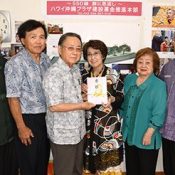
May 10, 2018 Ryukyu Shimpo
The money raised by the Hawaii Okinawa Plaza Fund Raising Committee for the construction cost of “Hawaii Okinawa Plaza” in Waipahu, Hawaii has reached 91 million yen, which means as of May 9 it has surpassed 90 percent of its 100 million yen goal.
The fund raising started in 2013. Approximately 1,500 municipalities, companies, organizations, and individuals have donated.
The committee is calling for cooperation to collect remaining 9 million yen by the time of the completion ceremony in September, in order to achieve its target amount of 100 million yen.
On November 9 Hanakotoba Kayo Tomo no Kai Executive Committee Chairman Sumiko Matayoshi and Executive Director Taeko Teruya visited Executive Secretary Asami Ginoza of the Fund Raising Committee, donating 400,000 yen of the profits from its charity show held in April in Naha.
Hanakotoba Kayo Tomo no Kai praised the postwar donation by Okinawans in Hawaii when they sent 550 pigs to support the postwar reconstruction of Okinawa.
It has held six charity shows in Okinawa and donated a total of 840 million yen as a way of repaying this past kindness.
Matayoshi and Teruya said, “We would like to give back from Okinawa.”
Ginoza thanked Matayoshi and Teruya for the donation and called for support from residents, saying, “Running the last corner of a track is hard, but at the completion ceremony in September we would like to report a 100 million yen donation from Okinawa.”
(English translation by T&CT and Megumi Chibana)
Go to Japanese










 Webcam(Kokusai Street)
Webcam(Kokusai Street)


